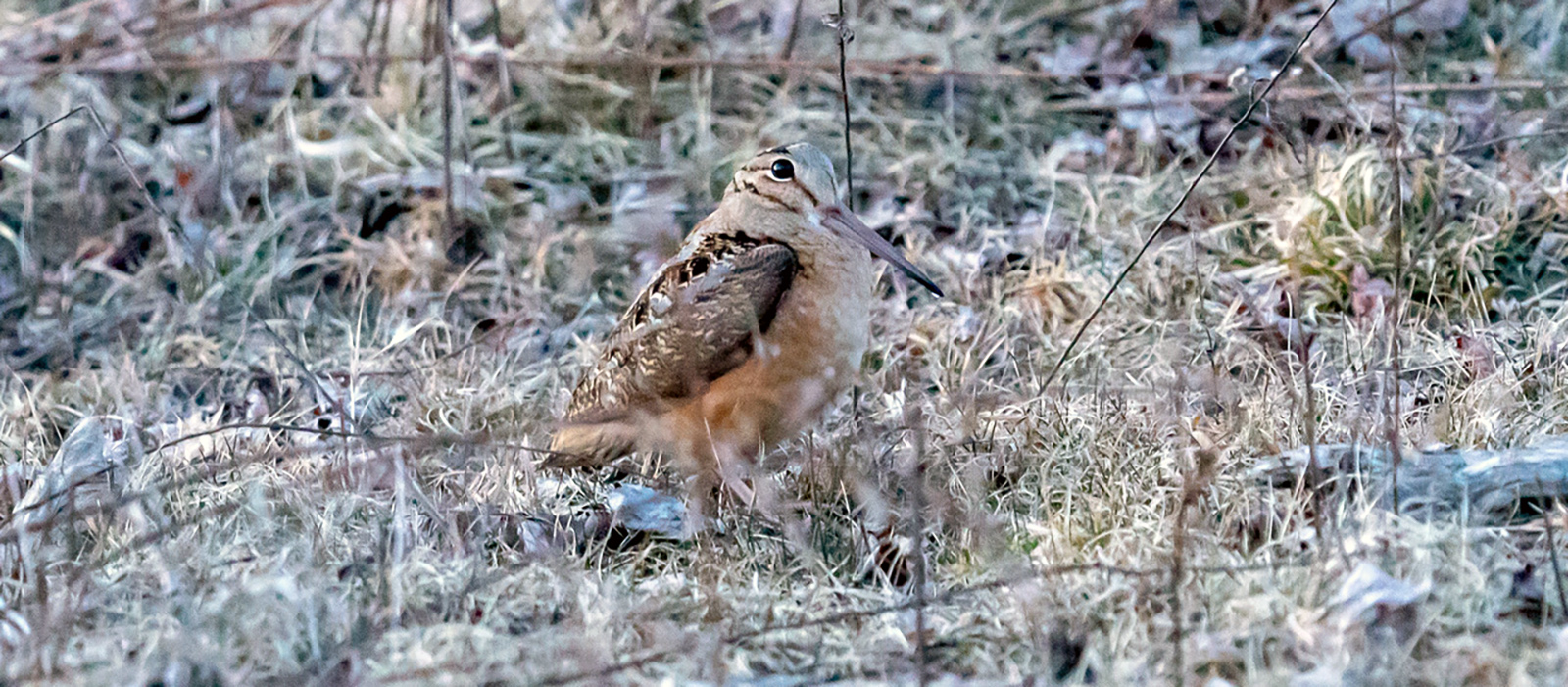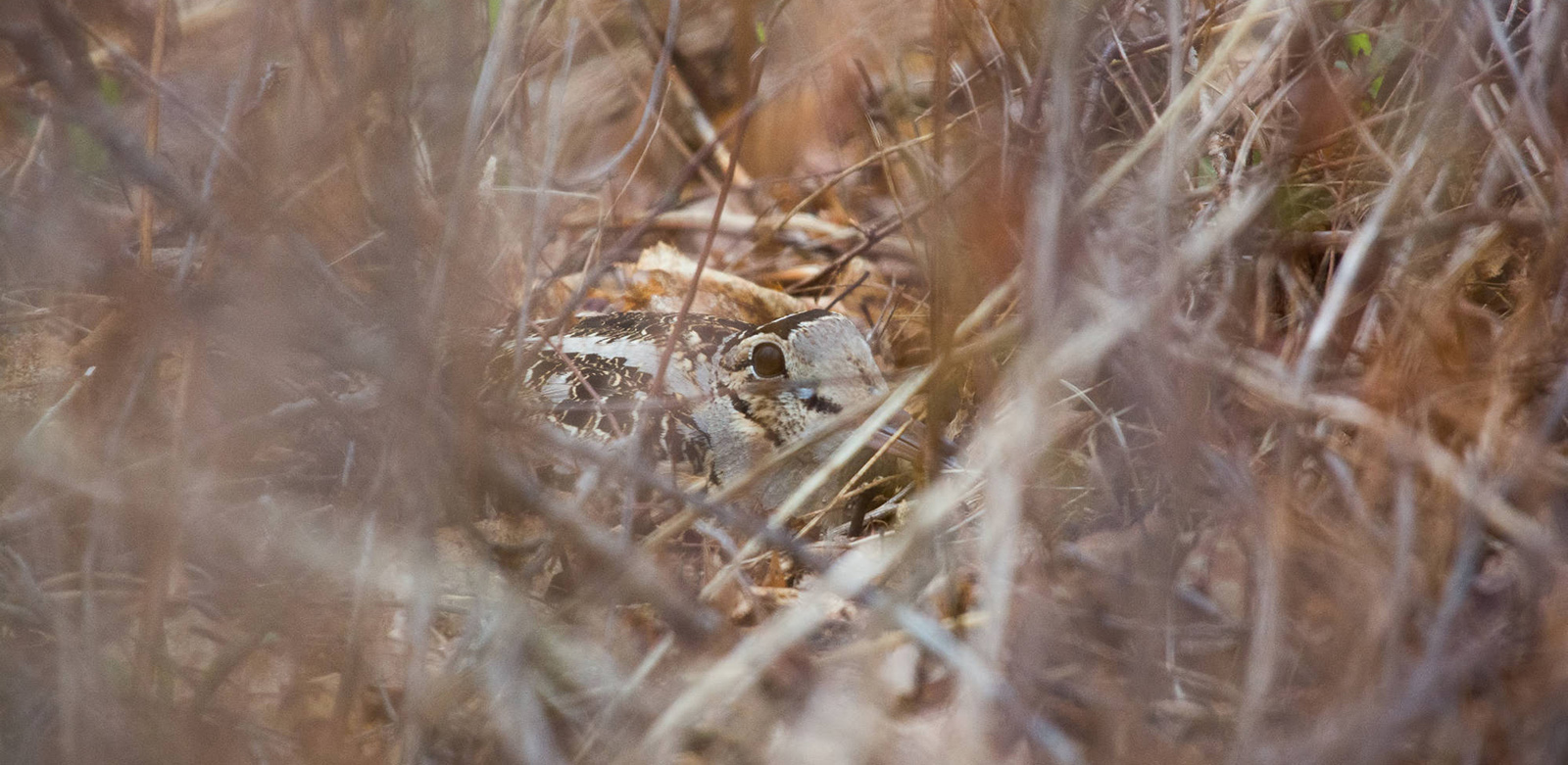Listen for the “Peent” to View Timberdoodles in Flight
By Matt Reilly
As the warm light of a late-winter afternoon fades to dusk on the rugged northern slopes of Mount Rogers, a group of excited naturalists flanks a large roadside meadow in an old highland farming valley. Even in the harsh, wild landscape of Virginia’s Mountain Empire, there’s a soft, hospitable hint of the warmer nights to come in the air. The sound of a rushing mountain stream, swollen with snowmelt and winter rains, roars in the background, while spring peepers sing in chorus. Then, as the sun hangs low on the horizon, something different.
Peent.
Right on time.
The far-off, nasally outburst emanating from the treeline sends waves of excitement through the group gathered by the roadside, for it’s the presence of the hidden vocalist and what’s to follow his call that brought them here.
The American woodcock (Scolopax minor), also referred to as a “timberdoodle,” is a forest-dwelling shorebird that populates much of the Old Dominion and other southeastern states during the colder months, when harsh winter weather spurs them to migrate south from the northern extent of their range. These birds make their living on the forest floor, foraging for subterranean foods like earthworms, grubs, and insect larvae, and are perfectly adapted to do so, sporting a small, round body; stout head; long, needle-like bill; and mottled, brown-black plumage.

An American woodcock. Photo by Matt Reilly
As they spend much of their time nestled on the ground amongst leaf litter, with their bills buried in the ground, their eyes are set high and pretty far back on their head, allowing them vision for detecting predators above, behind, and to their sides while foraging. The American woodcock is also unique among birds in that it has an upside-down brain. One evolutionary theory that aims to explain this anomaly suggests that, as the bird’s eyes moved rearward and its bill lengthened, its brain orientation was also affected. As a result, the woodcock’s cerebellum, which controls balance and coordination, came to reside at the base of its brain above the spinal column, while in most modern birds it’s located on the top of the brain.
Since their lifestyle and foraging habits require moist, soft soils, it’s largely held that long spells of cold weather that freezes their habitat in northern climes is the primary driver for woodcock migration. However, specific habits associated with the fall woodcock migration have been a source of wonder for ornithologists, wildlife viewers, and upland hunters for generations. Unlike its shorebird relatives, woodcock tend to be solitary and do not migrate in flocks, but are independently motivated to seek warmer, unfrozen habitats when the weather turns frigid, and often make many pit-stops on their journeys south. This collective trait can create the impression of community as individuals collect and move in and out of suitable cover at similar times. This habit, along with their secretive nature and excellent camouflage, can make determining and quantifying their presence challenging. Courtship flights, however, can eradicate the mystery of their presence quite spectacularly.

Woodcocks’ brown and gray mottled coloring makes them hard to spot in dry grasses. Photo by USFWS
When the ground is thawed and snow-free, and winter is on its last leg—usually late-February or early-March in Virginia—male woodcock will make courtship flights, or “sky dances,” above open fields, forest openings, and abandoned farmlands adjacent to good foraging habitat. These aerial displays take place in the half-hour before sunrise and after sunset daily during this time. The dance is preceded by intermittent calling from the ground, called “peenting.” A “peent” is an unmistakable, singular, short, nasally note that is blurted repetitively, interspersed by several seconds, while the male remains on the ground near open habitat, rotating every few seconds. Peenting can help wildlife viewers easily locate woodcock that would otherwise be secluded by thick cover, simply by walking or slowly driving through suitable habitat at dusk and dawn during the appropriate time of year, listening carefully. And if a bird can be located, the show to come is a real treat.
Peent.
It’s only a matter of time now.
After a few minutes of continued peenting, in the last shred of mountain light, the ball of anticipation harbored by the group of naturalists by the roadside meadow erupts as a male woodcock, at his most recognizable and awe-inspiring, launches himself skyward from a spot at the edge of the meadow in a silent, sloping ascent hundreds of feet high. After attaining proper altitude, the bird increases in speed and begins zig-zagging and looping erratically through the sky to the tune of a high-pitched twittering sound produced entirely by air passing through three specialized, narrow outer primary wing feathers. In the climax of his sky dance, the woodcock’s wing twittering grows less frequent, but comes in short, rapid bursts, accompanied by loud vocal chirping as he zig-zags downward, slopes, and plunges towards the ground near his launch site, with the sincere hope that a female will join him.
As quickly as it began, it’s over in the first moments of night.
Exuberant exhales from the naturalists fill the now dark roadside as the act concludes. To them, and to most of the natural world living in the shadow of Mount Rogers, a timberdoodle in flight is a harbinger more significant than a New Year’s ball or a groundhog’s lack of a shadow, and an awesome natural spectacle of one of our most covert native birds not to be missed.
Matt Reilly is a full-time freelance writer and fishing guide based in southwest Virginia.
Legal Disclaimer:
EIN Presswire provides this news content "as is" without warranty of any kind. We do not accept any responsibility or liability for the accuracy, content, images, videos, licenses, completeness, legality, or reliability of the information contained in this article. If you have any complaints or copyright issues related to this article, kindly contact the author above.
